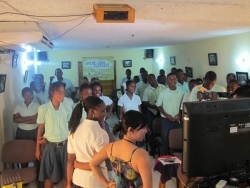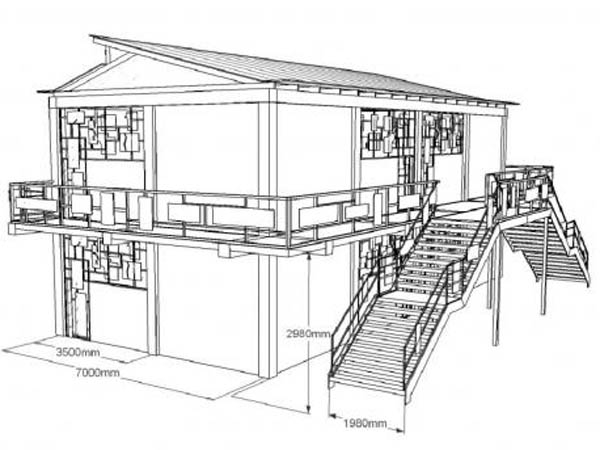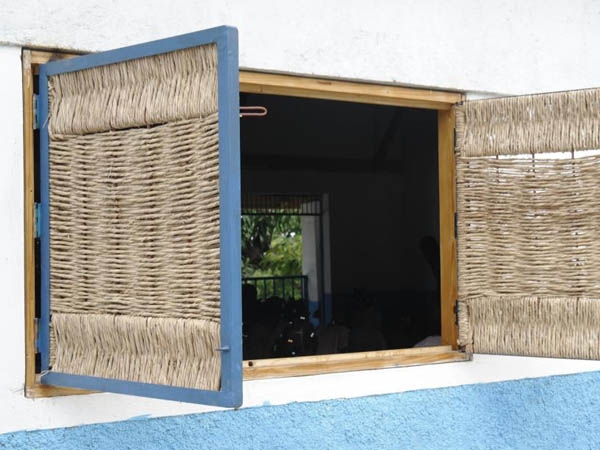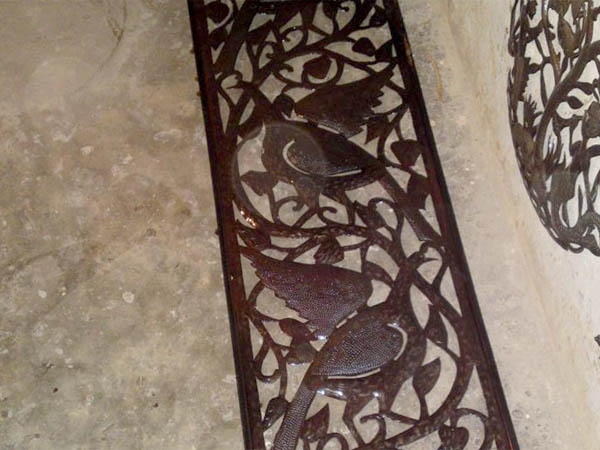How École Baptiste Bon Berger, Pele, had recently finished demolition on their defunct classroom block, clearing the way for new construction

As part of the Students Rebuild Interactive Videoconference sessions in Port-au-Prince this past week, I took the opportunity to update the students on their respective schools. I spoke with students from Baptiste Bon Berger, Pele, Elie Dubois and simultaneously over a dozen North American classrooms conferencing in for the hour-long discussions on architecture and Haiti’s way forward. about design and construction progress, taking the opportunity to present a few images to both the recipients and the funders…none of whom being older than 18.
For one of the sessions, I explained how École Baptiste Bon Berger, Pele, had recently finished demolition on their defunct classroom block, clearing the way for new construction. I showed the latest 3D drawings for Phase 1 (eight classrooms and a composting latrine), and examples of Haitian crafts we planned to incorporate in the architecture–including locally-manufactured reed woven window screens (a la Ceverine) and Haitian metalwork elements to adorn the railings.
It was also an ideal opportunity to garner some feedback on our designs from the students. The Pele kids were mostly concerned with improving their learning environment. Some of the old classrooms would leak in the rain, and there was always a mud patch right behind the main gate. Some of the classrooms were also unbearably hot certain times of the year. Problems like these are handily addressed in architectural designs, specifications and construction. The construction plans also outline the temporary circulation needed to route children around construction zones, so the 9th graders don’t have to worry about the younger kids wandering into the construction site.
The Pele kids also asked (en masse, mind you) that their standard classroom benches be replaced with something better. One boy commented “it’s not the best to always have to say ‘excuse me could you scoot over so I can sit down.'” He indicates the intently-listening White Plains, New York, classroom on the flatscreen, “we want to have proper desks like you guys.”
So where does the ‘architecture’ end in all of this? How much of a new building are we responsible for? Our priority is creating safe, durable and comfortable spaces to facilitate learning. We’re comfortable drawing the line here in part because other charity organizations are filling the gaps toward fully-equipped schools.

Pele school Phase 1 plan; Pele school block perspective
One such organization is Libraries without Borders (better known as Bibliothèques sans Frontieres), who have compiled volumes upon volumes of French books and textbooks to source libraries for schools around the world. Libraries without Borders can assemble a library according to a school headmaster’s wish list, and we’ve been collecting these lists from our clients for review.
It’s good that these conversations are happening now, while the projects are starting to break ground. It will still be several more months until the buildings are finished, but by then the books should have been ordered, shipped and cleared customs to be ready for introduction to the newly-rebuilt school. Organizations such as Libraries without Borders are meeting the more materials- and equipment-oriented needs of projects such as ours, and we’re seeking similar relationships for other non-architectural aspects, such as school desks.

Woven reed window screen at Ceverine school

Haitian metalwork sample for railings

School rendering as presented at the May 5 videoconference with Pele school


